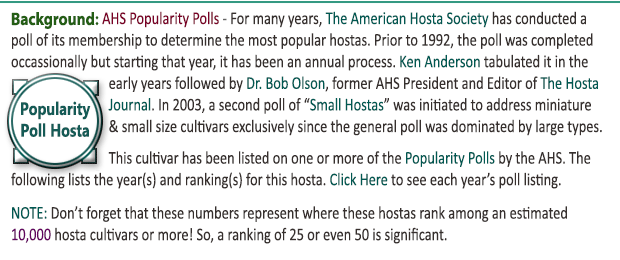|
  Introduced by
Gus Krossa
of Michigan who imported it from
Japan, this "classic" cultivar was registered in
1980 by his wife, Alma, after
his death.
The Hostapedia by
Mark Zilis (2009), states that it was "...registered
as a sterile offspring of
H. nigrescens... more likely a hybrid of
H. rectifolia x
H. nigrescens or
H. rectifolia
x 'Tokudama'..." Introduced by
Gus Krossa
of Michigan who imported it from
Japan, this "classic" cultivar was registered in
1980 by his wife, Alma, after
his death.
The Hostapedia by
Mark Zilis (2009), states that it was "...registered
as a sterile offspring of
H. nigrescens... more likely a hybrid of
H. rectifolia x
H. nigrescens or
H. rectifolia
x 'Tokudama'..."
 This
is a slow growing, giant size (33 inches high by 71 inches wide) plant with a vase shaped mound
of rich blue foliage. Its leaves are slightly wavy, smooth
textured with good substance. Medium lavender, funnel shape flowers are borne
on tall (3 to 5 feet tall) scapes from late July into August. It
does not produce seed. This
is a slow growing, giant size (33 inches high by 71 inches wide) plant with a vase shaped mound
of rich blue foliage. Its leaves are slightly wavy, smooth
textured with good substance. Medium lavender, funnel shape flowers are borne
on tall (3 to 5 feet tall) scapes from late July into August. It
does not produce seed.
According to
The Hostapedia by Mark Zilis (2009), this cultivar "...has become a hosta "classic" for many reasons.
The large-size, vase-shaped mound of frosty blue foliage is
slug resistant and makes the perfect centerpiece plant for
almost any garden."
This cultivar has appeared on several of the Popularity Polls by
members of The American Hosta Society (see below). This cultivar has been
awarded the Royal Horticultural Society's Award of Garden Merit
in the
UK.
 "AHS
Eunice Fisher Award, 1974. Plant is a sterile descendant of
H. nigrescens. Imported from Japan by Krossa in the 1950s
and by him cultivated under H. 'Krossa No. A-3'...Widely
cultivated, it attained the No. 2 position in The American Hosta
Society popularity poll for 1988. During tissue culture several
mutant forms have appeared and have been named: H.
'Porcelain Vase'...which is a mediovariegated greenish white
with dark green margins, and H. Regal Splendor...a
whitish yellow margined..." "AHS
Eunice Fisher Award, 1974. Plant is a sterile descendant of
H. nigrescens. Imported from Japan by Krossa in the 1950s
and by him cultivated under H. 'Krossa No. A-3'...Widely
cultivated, it attained the No. 2 position in The American Hosta
Society popularity poll for 1988. During tissue culture several
mutant forms have appeared and have been named: H.
'Porcelain Vase'...which is a mediovariegated greenish white
with dark green margins, and H. Regal Splendor...a
whitish yellow margined..."
 From the
Field Guide to Hostas by Mark Zilis (2014), "...is known for its "blue" foliage, its early season color is
actually more of a powdery or silvery grey that differs from the
blues of the
Sieboldianas and Tokudamas." From the
Field Guide to Hostas by Mark Zilis (2014), "...is known for its "blue" foliage, its early season color is
actually more of a powdery or silvery grey that differs from the
blues of the
Sieboldianas and Tokudamas."
The New Encyclopedia of Hostas by
Diana
Grenfell (2009) states: "Of great architectural merit as a specimen and
good in a large container, which must be kept well-watered.
Outstanding in leaf and flower. Winner of the 2001 Alex J.
Summers Distinguished Merit Hosta Award."
W. George Schmid in his
Hosta Species Update on The Hosta
Library (2007) says, "The plant originated in Japan with
Osaka University (a source of a number of Japanese plants
for G. Krossa). Its Japanese vernacular name is based on its
size and silvery color, being Chodai Giniro Gibōshi. Translated
this name means “exceptionally large, silver colored hosta.
western equivalent...would be H. ‘Chodai Giniro’ but it is
registered as H. ‘Krossa Regal’ and known under this name
the world over. This hosta can be seen in most hosta
collec-tions. It has the same vase-shaped clump as H.
nigrescens with silvery leaves and tall scapes as the parent
species.”
Mikiko Lockwood in an article on The Hosta Library titled,
A Little About Japanese Hosta Terms defines the term ginba as silver (white) leaf.


An article by C.H. Falstad about the stability of colors in hosta leaves in
The
Hosta Journal (2006 Vol. 37 No. 1) says, "The least
stable hostas tend to be those with streaked leaves...In September, 1982 I found
the first streaked forms of 'Krossa Regal'...Today, more than 20 years later,
most of those clumps remain predominately streaked...In comparison, I once owned
a plant of 'Yellow Splash'...Within a year or two, it turned entirely into
'Yellow Splash Rim'..."


 |
 |
 |
 |
| 27 |
9.5 |
1975 #2
1984 #4
1985 #3
1990 #7
1991 #10
1992 #10 |
1993 #8
1994 #7
1995 #8
1996 #6
1997 #6
1998 #10 |
1999 #10
2000 #9
2001 #13
2002 #10
2003 #8
2004 #8 |
2005 #7
2006 #19
2007 #6
2009 #8
2011 #12
2012 #9 |
2014 #16
2015 #21
2017 #18 |
|
|





|



